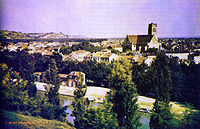- Subtractive color
-
 An 1877 color photo by Louis Ducos du Hauron, a French pioneer of color photography. The overlapping, subtractive yellow, cyan and red (magenta) image elements can clearly be seen.
An 1877 color photo by Louis Ducos du Hauron, a French pioneer of color photography. The overlapping, subtractive yellow, cyan and red (magenta) image elements can clearly be seen.
A subtractive color model explains the mixing of paints, dyes, inks, and natural colorants to create a full range of colors, each caused by subtracting (that is, absorbing) some wavelengths of light and reflecting the others. The color that a surface displays depends on which colors of the electromagnetic spectrum are reflected by it and therefore made visible.
Subtractive color systems start with light, presumably white light. Colored inks, paints, or filters between the viewer and the light source or reflective surface subtract wavelengths from the light, giving it color. If the incident light is other than white, our visual mechanisms are able to compensate well, but not perfectly, often giving a flawed impression of the "true" color of the surface.
Conversely, additive color systems start without light (black). Light sources of various wavelengths combine to make a color. In either type of system, three primary colors are combined to stimulate humans’ trichromatic color vision, sensed by the three types of cone cells in the eye, giving an apparently full range.
Contents
Wavelength absorbsion
The following flowchart illustrates an example of the process, step by step.
Light source S M L White light radiates from the light source. ↓ ↓ ↓ Cyan ink S M — Cyan ink absorbs long wavelengths, allowing the rest to pass through. Yellow ink — M L Yellow ink absorbs short wavelengths, allowing the rest to pass through. The only wavelengths remaining are medium, which are green. ↓ Paper S M L The medium wavelengths reflect off of the paper. ↓ Yellow ink — M L The medium wavelengths pass back through the yellow ink. Cyan ink S M — The medium wavelengths pass back through the cyan ink. ↓ Retina S M L The medium wavelengths activate the M cones in the retina. ↓ Brain S M L The brain interprets the signal from the M cones as green. In order to fully understand the process, it should be demonstrated how black is obtained using red, green, and blue.
Light source S M L White light radiates from the light source. ↓ ↓ ↓ Green ink — M — Green ink absorbs short and long wavelengths, allowing medium wavelengths to pass through. ↓ Red ink — — L Red ink absorbs short and medium wavelengths, allowing long wavelengths to pass through. However, there are no long wavelengths remaining to pass through, and all of the light has been absorbed. RYB
RYB (Red, Yellow, Blue) is the formerly standard set of subtractive primary colors used for mixing pigments. It is used in art and art education, particularly in painting. It predated modern scientific color theory.
Red, yellow, and blue are the primary colors of the standard color "wheel". The secondary colors, violet (or purple), orange, and green (VOG) make up another triad, formed by mixing equal amounts of red and blue, red and yellow, and blue and yellow, respectively.
The RYB primary colors became the foundation of 18th century theories of color vision as the fundamental sensory qualities blended in the perception of all physical colors and equally in the physical mixture of pigments or dyes. These theories were enhanced by 18th-century investigations of a variety of purely psychological color effects, in particular the contrast between "complementary" or opposing hues produced by color afterimages and in the contrasting shadows in colored light. These ideas and many personal color observations were summarized in two founding documents in color theory: the Theory of Colors (1810) by the German poet and government minister Johann Wolfgang von Goethe, and The Law of Simultaneous Color Contrast (1839) by the French industrial chemist Michel-Eugène Chevreul.
CMYK printing process
In most color printing, the primary ink colors used are cyan, magenta, and yellow. Cyan is the complement of red, meaning that cyan acts like a filter that absorbs red. The amount of cyan applied to a paper will control how much red will show. Magenta is the complement of green, and yellow the complement of blue. Combinations of different amounts of the three inks can produce a wide range of colors; this is how artwork reproductions are mass-produced, although an under-toning of black ink is usually used as well. This mixture is called CMYK.
See also
References
- Berns, Roy S. (2000). Billmeyer and Saltzman's Principles of Color Technology, 3rd edition. Wiley, New York. ISBN 0-471-19459-X.
- Stroebel, Leslie, John Compton, Ira Current, and Richard Zakia (2000). Basic Photographic Materials and Processes, 2nd edition. Focal Press, Boston. ISBN 0-240-80405-8.
- Wyszecki, Günther and W. S. Stiles (1982). Colour Science: Concept and Methods, Quantitative Data and Formulae. Wiley, New York. ISBN 0-471-02106-7.
External links
- Stanford University CS 178 interactive Flash demo comparing additive and subtractive color mixing.
Color topics Color perception Color space Hue · Lightness · Colorfulness · Additive color · Subtractive color · Primary color · Secondary color · Tertiary color
Basic colors Related Categories:
Wikimedia Foundation. 2010.


